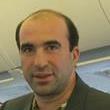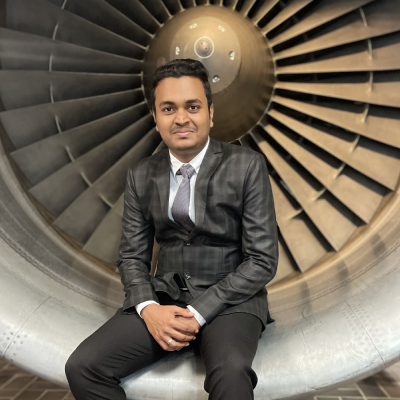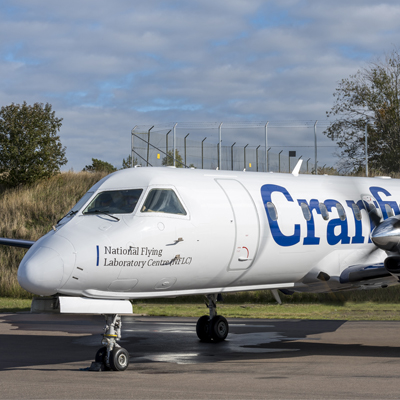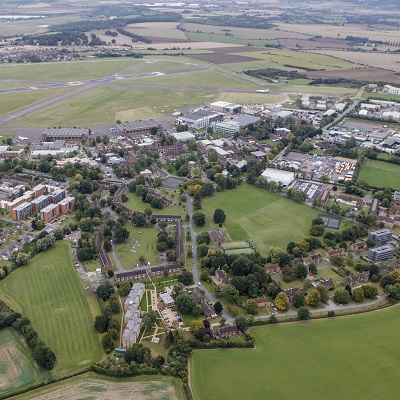Please note: For March 2026 entry, international and European applicants requiring ATAS clearance must apply by 4 December 2025. International applicants who do not need ATAS must apply by 11 December 2025, and UK or Irish applicants by 5 March 2026. Early application is strongly recommended.
Overview
- Start dateSeptember or March
- DurationOne year
- DeliveryTaught modules 10% | Group project 50% | Individual research project 40%
- QualificationMSc
- Study typeFull-time
- CampusCranfield campus
Who is it for?
This course is suitable for students with a background in aeronautical or mechanical engineering or those with relevant industrial experience. It provides a taught engineering programme with a focus on the technical, business and management aspects of aircraft design in the civil and military aerospace sectors.
Why this course?
The Avionic Systems Design option aims to provide an understanding of avionic systems design, analysis, development, test and airframe integration. This includes a detailed look at robust and fault-tolerant flight control, advanced 4D flight management and RNP navigation, self-separation and collision avoidance and advanced digital data communications systems, as well as pilot-friendly and intelligent cockpit displays and situation awareness.
The course also covers future ATM systems which have been at the forefront of postgraduate education in aerospace engineering since 1946. Aerospace Vehicle Design at Cranfield University was one of the original foundation courses of the College of Aeronautics. Graduates of this course are eligible to join the Cranfield College of Aeronautics Alumni Association (CCAAA), an active community which hold a number of networking and social events throughout the year.
You will have the opportunity to fly during a Student Experience Flight in our National Flying Laboratory Centre’s (NFLC) light aircraft. This flight experience will complement your MSc studies, focussing on the effects of controls, aircraft stability and angle of attack. During the flight you will have the opportunity to take control of the aircraft. Each experience is 2 to 3 hours in duration and includes a pre-flight safety briefing outlining the details of the manoeuvres to be flown, a flight of approximately 1 hour, and a post-flight debrief. Read Hari's blog on his flight experience.
Cranfield University is well located for students from all over the world, and offers a range of library and support facilities to support your studies. This enables students from all over the world to complete this qualification whilst balancing work/life commitments.
Informed by industry
The course has an Industrial Advisory Committee with senior members from major UK aerospace companies, government bodies and the military services. The committee meets twice a year to review and advise on course content, acquisition skills and other attributes are desirable from graduates of the course. Panel members include:
• Airbus,
• BAE Systems,
• Boeing,
• Department of National Defence and the Canadian Armed Forces,
• GKN Aerospace,
• Messier-Dowty,
• Royal Air Force,
• Royal Australian Air Force,
• Thales UK.
We also arrange visits to sites such as BAE Systems, Thales, GKN and RAF bases which specialise in the maintenance of military aircraft. This allows you to get up close to the aircraft and components to help with ideas for the group project.
Course details
This option comprises 16 mandatory modules and six optional modules. You are also required to complete a group design project and an individual research project. Delivered via a combination of structured lectures, industry guest lectures, computer based workshops and private study.
A unique feature of the course is that we have four external examiners: two from industry who assess the group design project and two from academia who assess the individual research project.
Course delivery
Taught modules 10% | Group project 50% | Individual research project 40%
Group project
The extensive group design project is a distinctive and unique feature of this course. This teamwork project takes place over six months, usually between October and March, and recreates a virtual industrial environment bringing together students with various experience levels and different nationalities into one integrated design team.
You will be given responsibility for the detailed design of a significant part of the aircraft, for example, flight control system or navigation system. The project will progress the design of the aircraft and avionic systems from the conceptual phase through to the preliminary and detail design phases. You are required to run project meetings, produce system schematics and conduct detailed analyses of their design. Problem solving and project coordination must be undertaken on a team and individual basis. At the end of the project, groups are required to report and present findings to a panel of up to 200 senior engineers from industry.
This element of the course is both real and engaging, and places the student group in a professional role as aerospace design engineers. Students testify that working as an integrated team on real problems is invaluable and prepares them well for careers in a highly competitive industry.
Watch past presentation YouTube videos to give you a taster of our innovative and exciting group projects:
Individual project
The individual research project aims to provide the training necessary for you to apply knowledge from the taught element to research, and takes place over six months. The project may be theoretical and/or experimental and drawn from a range of topics related to the course and suggested by teaching staff, your employer or focused on your own area of interest.
Example avionic systems design and analysis topics:
Design and implementation of real time ADS-B system based on software defined radio;
4D integrated flight management and traffic avoidance software system;
Station keeping for flight formation in oceanic airspace;
Air to air refuelling formation behaviour;
Study and development of air traffic control (ATC) tower simulation;
RPAS/UTM integration simulation;
Geo-fencing software system;
Intelligent diagnostics/prognostics (IDP) system;
Flight formation in oceanic airspace;
Development of navigation algorithms, based on surfaces of situation (non-autonomous);
Flight guidance systems to allow aircraft fly safely and efficiently within flow corridors;
Passenger egress simulation based on artificial intelligence approach;
Investigation into remote co-pilot concept for strategic single-pilot operation;
Slung load control;
FPGA implementation of gain scheduled controllers;
Flight control desktop demonstrator.
Modules
Keeping our courses up-to-date and current requires constant innovation and change. The modules we offer reflect the needs of business and industry and the research interests of our staff and, as a result, may change or be withdrawn due to research developments, legislation changes or for a variety of other reasons. Changes may also be designed to improve the student learning experience or to respond to feedback from students, external examiners, accreditation bodies and industrial advisory panels.
To give you a taster, we have listed the compulsory and elective (where applicable) modules which are currently affiliated with this course. All modules are indicative only, and may be subject to change for your year of entry.
Course modules
Compulsory modules
All the modules in the following list need to be taken as part of this course.
Design of Airframe Systems
| Module Leader |
|
|---|---|
| Aim |
|
| Syllabus |
|
| Intended learning outcomes |
On successful completion of this module you should be able to:
|
Cockpit Environment
| Aim |
|
|---|---|
| Syllabus |
|
| Intended learning outcomes |
On successful completion of this module you should be able to:
|
Modelling of Dynamic Systems
| Aim |
To provide an understanding of the mathematical techniques that underpin both classical and modern control law design. |
|---|---|
| Syllabus |
|
| Intended learning outcomes |
On successful completion of this module you should be able to: 1. Use Laplace transform techniques to derive transfer functions of typical mechanical, electrical and fluid systems. 2. Calculate and plot the step and frequency responses of linear systems. 3. Derive the state equations for typical systems. 4. Obtain discrete time representations of linear systems. 5. Use MATLAB for matrix and systems algebra and to plot system responses. |
Avionics Air Traffic Control
| Aim |
This module aims to provide you with an understanding of current and future air traffic control and traffic flow management systems. The objective is to discuss current ATM standards and technology applied in the systems and to review the future concepts as described by SESAR/NextGen. |
|---|---|
| Syllabus |
• Air Traffic Control and Air Traffic Management. • Air Traffic Control, Organizational Elements. • Airspace Design. • Air Traffic Control as Human Supervisory Control System. • Air Traffic Control Operations. • ATC Conflict Assessment. • ATM Challenges. |
| Intended learning outcomes |
On successful completion of this module you should be able to:
|
Aircraft Stability and Control
| Module Leader |
|
|---|---|
| Aim |
To provide an introduction to the fundamentals of aircraft stability and control. |
| Syllabus |
|
| Intended learning outcomes |
On successful completion of this module you will be able to:
|
Reliability, Safety Assessment and Certification
| Aim |
To provide you with an introduction to the aircraft airworthiness as well as knowledge of reliability assessment methods, safety assessment methods, and certification issues associated with the design of Aircraft Systems (including weapon systems and survivability). To familiarise you with current air accidents investigation techniques and processes. |
|---|---|
| Syllabus |
|
| Intended learning outcomes |
On successful completion of this module you should be able to:
|
Control Systems
| Aim |
To provide knowledge of the fundamentals of control engineering for the analysis and design of control systems in aerospace applications. |
|---|---|
| Syllabus |
|
| Intended learning outcomes |
On successful completion of this module a you should be able to: 1. Analyse and explain the stability, characteristics, behaviour and robustness of single input/ single-output feedback control systems. 2. Design controllers for single-input single-output systems. 3. Use modern PC-based CAD software to solve control engineering problems and design control systems using classical methods. 4. Recognise and explain the advantages and limitations of feedback and recognise the importance of robustness. |
Inertial and Satellite Navigation Systems
| Aim |
To provide you with a comprehensive knowledge of inertial and satellite navigation systems. |
|---|---|
| Syllabus |
Inertial sensor technology: Mechanisation equations: Inertial navigation systems design: Overview of GNSS – GPS, GLONASS, GALILEO and other systems: GPS positioning principles: Augmentation of GNSS: GNSS Aviation Applications: |
| Intended learning outcomes |
On successful completion of this module a you should be able to:
|
Aerospace Software Engineering and Ada
| Aim |
• To give you an understanding of Ada language and the programming techniques. |
|---|---|
| Syllabus |
• Design methodologies. • Top-down vs bottom-up approaches. • Object oriented design. • Design for reusability and maintainability. • Real-time considerations. • Software verification and validation - Formal methods and standards. • The Ada language. The LRM, data and programming structures. |
| Intended learning outcomes |
On successful completion of this module you should be able to:
|
Aircraft Performance
| Module Leader |
|
|---|---|
| Aim |
To facilitate you in gaining fundamental knowledge of the theory of conventional fixed wing aircraft performance to a level suitable for an aerospace vehicle designer. In particular, to provide you with the ability to apply aircraft performance theory, practically in the context of aerospace vehicle design. |
| Syllabus |
|
| Intended learning outcomes |
On successful completion of this module you should be able to:
|
Radio Systems
| Aim |
|
|---|---|
| Syllabus |
Terrestrial Radio Navigational Aids. DF, NDB, MB, VOR & DVOR, DME, ILS, MLS, TACAN. Doppler Navigation. Radar |
| Intended learning outcomes |
On successful completion of this module you should be able to:
|
Flight Control and Autopilot Systems
| Aim |
|
|---|---|
| Syllabus |
Flight Dynamics Introduction to Aircraft Control Systems Fly-by-Wire (FBW) Flight Control Autopilot Systems |
| Intended learning outcomes |
On successful completion of this module you should be able to:
|
Aeronautical Communication Systems
| Aim |
To study different avionics communication systems and to provide you with an understanding in fundamental issues relating to communication systems design, integration and testing. |
|---|---|
| Syllabus |
• Multiplexing and multiple access techniques (such as FDMA, TDMA, CDMA, CSMA, etc) • Modulation and demodulation techniques (such as QPSK, BPSK, M-ray, Noncoherent and coherent Demodulation methods) • Requirements for digital links systems • VDL system design (Mode 2, 3, 4) • Digital HF radio design, SATCOM system design • Installation and integration |
| Intended learning outcomes |
On successful completion of this module you should be able to:
|
Avionics Data Networking, Hardware Intergration and Testing
| Aim |
To study different data-bus architectures and to provide you with an understanding in fundamental issues relating to avionic hardware design, integration and testing. |
|---|---|
| Syllabus |
• Avionics systems architectures – Federated, distributed, centralised, IMA. • Aircraft data networks – Fundamental concepts: architectures, topologies and protocols. • Aircraft data networks – Military, civil and commercial examples, including ARINC 429, ARINC 629, ARINC 659, MIL-1553, STANAG 3910, ACSB, CSDB and AFDX. • Avionics systems integration and testing – Fundamental concepts. • Avionics rig and laboratory functional tests. • Avionics EMC/EMI and environmental testing. • Avionics flight test techniques and instrumentation. • Experimental data analysis methods. |
| Intended learning outcomes |
On successful completion of this module you should be able to:
|
Integrated Navigation Systems
| Aim |
To introduce you to the advanced techniques for design and development of integrated aircraft navigation systems. |
|---|---|
| Syllabus |
|
| Intended learning outcomes |
On successful completion of this module you should be able to:
|
Fault Tolerant Avionics Design
| Aim |
To introduce the you to the principal methods for the design and development of fault – tolerant avionics systems. |
|---|---|
| Syllabus |
• Fault, cause and effect. • Hardware fault tolerance. • Software fault tolerance. • Failure detection techniques. • Design of practical fault-tolerant avionics systems. • Case study – Fault-tolerant navigation systems and flight control systems. |
| Intended learning outcomes |
On successful completion of this module you should be able to:
|
Flight Test Experience
| Module Leader |
|
|---|---|
| Aim |
To provide you with flights in the Flying Laboratory in support of the lecture course in Aircraft Aerodynamics, Aircraft Performance, and Aircraft Stability and Control. These flights are key for students who are from a non-aeronautical background, and will also serve as a refresher for the remaining students. |
| Syllabus |
|
| Intended learning outcomes |
On successful completion of this module you should be able to:
|
Elective modules
Fifteen of the modules from the following list need to be taken as attendance only modules.
Aircraft Aerodynamics
| Module Leader |
|
|---|---|
| Aim |
The aim of this module is to provide you with the knowledge of the Atmosphere and of the basic aerodynamic characteristics of a conventional aircraft in the context of its mechanics of flight. |
| Syllabus |
This module has additional accompanying flying laboratory tutorials in the Jetstream Aircraft. See Flight Experimental Methods (FXM). |
| Intended learning outcomes |
On successful completion of this module a you should be able to:
|
Computer Aided Design
| Aim |
The aim of this module is to introduce you to the role of Computer Aided Design technologies in a modern Integrated Product Development process and provide hands-on experience of CAD using the CATIA v5 software. |
|---|---|
| Syllabus |
Introduction to Integrated Product Development (IPD) for aircraft design. Overview of Computer Aided Design, Manufacture and Engineering tools and their role in IPD. Introduction to CAD modelling techniques: Hands on CATIA exercises using CATIA v5 including fuselage and wing design exercises. Using CATIA for the Group Design Project. |
| Intended learning outcomes |
On successful completion of this module you should be able to:
|
Aerospace System Development and Life Cycle Model
| Aim |
To introduce you to system engineering concepts, system lifecycle models and system design processes and methods. |
|---|---|
| Syllabus |
|
| Intended learning outcomes |
On successful completion of this module you should be able to:
|
Initial Aircraft Design
| Module Leader |
|
|---|---|
| Aim |
|
| Syllabus |
|
| Intended learning outcomes |
On successful completion of this module you should be able to:
|
Integrated Vehicle Health Management
| Module Leader |
|
|---|---|
| Aim |
To provide you with an introduction to the leading IVHM technologies and concepts being implemented in various health monitoring systems, and their application to aircraft design. |
| Syllabus |
|
| Intended learning outcomes |
On successful completion of this module a you should be able to:
|
Aircraft Power Plant Installation
| Aim |
To introduce you to the engine and aircraft-related aspects of the propulsion system, with the primary emphasis being placed on gas turbine engines. |
|---|---|
| Syllabus |
|
| Intended learning outcomes |
On successful completion of this module you should be able to:
|
Teaching team
You will be taught by a wide range of subject specialists from the University and industry professionals who draw on their research and industrial expertise to provide stimulating and relevant input to your learning experience. The teaching on some taught modules is also supported by visiting speaker's lectures from both industry and the military. Former speakers have included senior representatives from Airbus, BAE Systems, Boeing and Eurocopter. The Course Director for this programme is Jack Stockford.
Accreditation
The Aerospace Vehicle Design MSc is accredited by Mechanical Engineers (IMechE) and the Royal Aeronautical Society (RAeS) on behalf of the Engineering Council as meeting the requirements for further learning for registration as a Chartered Engineer (CEng). Candidates must hold a CEng accredited BEng/BSc (Hons) undergraduate first degree to show that they have satisfied the educational base for CEng registration.
Your career
The Avionic Systems Design option is valued and respected by employers worldwide. The applied nature of this course ensures that our graduates are ready to be of immediate use to their future employer and has provided sufficient breadth of understanding of multi-discipline design to position them for accelerated career progression.
This course prepares graduates for careers as project design engineers, systems design, structural design or avionic engineers in aerospace or related industries, with the aim of progressing to technical management/chief engineer. Graduates from the MSc in Avionic Systems Design can therefore look forward to a varied choice of challenging career opportunities in the above disciplines.
Many of our graduates occupy very senior positions in their organisations, making valuable contributions to the international aerospace industry. Typical student destinations include BAE Systems, Airbus, Dassault and Rolls-Royce.
Cranfield’s Career Service is dedicated to helping you meet your career aspirations. You will have access to career coaching and advice, CV development, interview practice, access to hundreds of available jobs via our Symplicity platform and opportunities to meet recruiting employers at our careers fairs. Our strong reputation and links with potential employers provide you with outstanding opportunities to secure interesting jobs and develop successful careers. Support continues after graduation and as a Cranfield alumnus, you have free life-long access to a range of career resources to help you continue your education and enhance your career.
How to apply
Click on the ‘Apply now’ button below to start your online application.
See our Application guide for information on our application process and entry requirements.
My course prepared me to be an aircraft designer with good hands-on experience in design software, planning and budgeting for projects. Here I have learnt team work and project management skills. Using these skills I have set up a company back in India which focuses on the engineering applications of drones.
As a person who always had a dream of becoming a flight test engineer in the aerospace sector, I felt that the Flight Experience module - onboard Cranfield's Saab 340B, the flying classroom - was valuable as an initial insight on how a flight test is conducted within the industry. It really helped me to understand and verify the overall theory evolving the flight physics both in term of lift and drag, as well as the stability of the aircraft.
I chose to study Aerospace Vehicle Design MSc at Cranfield University as it was a unique course that would give me the opportunity to specialise in the design of aircraft. A highlight from my MSc would have to be the group design project and meeting new friends from all around the world. It made the entire journey a breeze, with a lot of support and many late nights. Once I have finished my MSc I will be starting new job at Airbus.
I chose to study at Cranfield University because of the feedback provided by former students, so as well as its ties with industry. The Aerospace Vehicle Design MSc was was exactly what I was looking for in terms of the theory covered in the taught modules and being able to apply this to the group and thesis projects.
A highlight from my time at Cranfield University would have to be taking part in the flying experience onboard the Cranfield acrobatic plane.
Postgraduate study is not for everyone, but if you want to find your limits and expand your capabilities, then give it a go. I found it tough but extremely rewarding.
Cranfield is a prestigious university and well-known in the engineering field. I am not good at exams, and I found the group project-oriented course really suited me and allowed me to excel beyond what I thought I could achieve at the beginning of the course.
A highlight of my time at Cranfield University definitely was in the first few weeks being in awe of everything, the knowledge, the facilities and the aircraft flying overhead during lessons really pushed me.










.ashx?h=400&w=400&la=en&hash=AE9FD4CF161A12723C148F896750A589F2572111)
.ashx?h=400&w=400&la=en&hash=0BFF94E45A6A0215247DBA659AC1856DF5547666)




